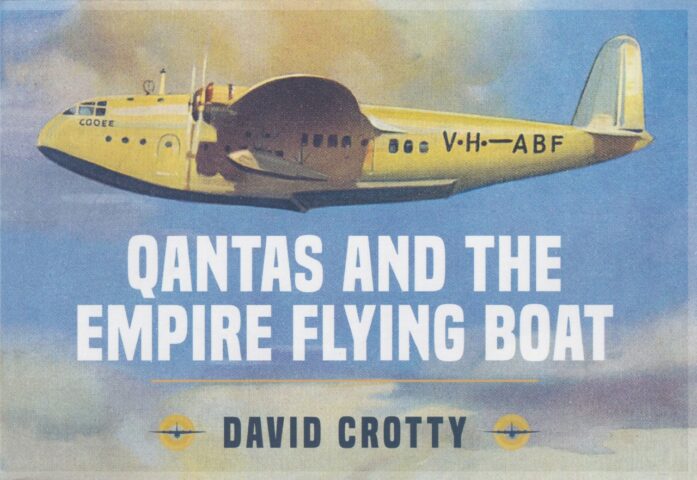Book review by Ian Debenham OAM

The title of this book is an apt description of the contents of this book. It is focussed on the Short S.23 flying boats — otherwise known as the Short Empire flying boat and the ‘C’ class in Imperial Airways aircraft classification — designed and built by Short Brothers at their works at Rochester near the river Medway, in the County of Kent, England. The book focusses on the operation of this aircraft type by Qantas Empire Airways and the author of the book, David Crotty, is well placed to document this operation. Currently he is the Curator of the Qantas Heritage Collection. David comes from a career as a curator of technology; first with the RAAF Museum at Point Cook; then with the Museum of Victoria before becoming the curator of the Qantas collection in 2012. As the book acknowledges, all the images in this copiously illustrated volume are held in the Qantas Heritage Collection.
The book is divided into fifteen chapters. The first three: ‘Striving for Empire’, ‘Airline Empires’, and ‘Fighting Empires’ document the Qantas history of operation of these aircraft from the arrival of the first of the six Qantas-ordered ‘C’ class boats, Coolangatta, in Australia in 1938 with a background to the business of the partnership with Britain’s Imperial Airways and the fraught introduction of the Empire Air Mail Scheme (EAMS). David’s skill as a researcher and a writer is well displayed in his handling of the information available to him. Alongside the information from the Qantas perspective, he documents the development of the aircraft by Shorts and draws attention to the crew training and engineering aspects required by Qantas to adapt to the new technology of the ‘C’ class boats. Handling large flying boats by the Qantas pilots was a novel aspect for them compared with their usual operation of land planes through the barren north of Australia.
A further difficulty arising before the operation of the flying boats by Qantas was the activity of a land plane lobby that was in danger of swaying the Australian Government against the use of the boats but, ultimately, to no avail. The arrival of Centaurus in Sydney in 1937 created much positive publicity when it alighted at Rose Bay, the location of the proposed international air terminal. From this point David continues to chronicle the development of the Qantas ‘C’ class fleet and their delivery to Australia with attendant recognition of the infrastructure and route engineering requirements. The third chapter, as the title implies, deals with the Qantas ‘C’ class activity during the Second World War. The narrative carries the reader on to follow the steps taken to modify the boats for war service and the Qantas crews were also recruited into military service to fly them. Not all aircraft and crews survived. David’s narrative is detailed but never tedious. In fact, I found it very engaging, and one feels very much inclined to accept his scholarship as accurate.
Chapter 3 brings to an end the history of Qantas’ use of the Short ‘C’ class flying boats. From chapter four to chapter 15 David devotes each chapter to a single ‘C’ class aircraft, the aircrafts’ names heading the chapters. In order these are: Carpentaria, Coolangatta, Coogee, Corio, Coorong, Cooee, Coriolanus, Camilla, Clifton, Centaurus, Calypso, and Circe. Each chapter is prefaced by a brief account of the significant historical aspects related to the aircraft’s construction and operation. The rest of each chapter is a photographic essay of the named aircraft.
David Crotty’s book complements the books by Sir Wilmot Hudson Fysh on the history of Qantas (Qantas Rising, Qantas at War and Wings to the World), E Bennett-Bremner’s Front-Line Airline and those of the administrative history of Qantas by John Gunn (The Defeat of Distance, High Corridors and Challenging Horizons). For a perspective from Imperial Airways for which the ‘C’ class boats were originally designed and built, the appropriate chapters in Harald Penrose’s Wings Across the World are a quick read.
Published by Key Books, 2021
Ian Debenham OAM

